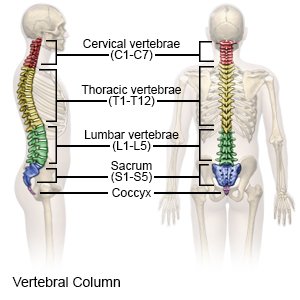Cervical Facet Block
Medically reviewed by Drugs.com. Last updated on Apr 6, 2025.
WHAT YOU NEED TO KNOW:
A cervical facet block is a procedure to inject medicine at the facet joints in your cervical (neck) spine. Facet joints are found at the back of each vertebrae.
 |
HOW TO PREPARE:
The week before your procedure:
- Arrange to have someone drive you home after your procedure.
- Tell your healthcare provider about all the medicines you currently take. He or she will tell you if you need to stop any medicine before the procedure, and when to stop. He or she will tell you which medicines to take or not take on the day of the procedure.
- Tell your provider about all your allergies. Tell him or her if you had an allergic reaction to anesthesia, antibiotics, or contrast liquid.
- You may need to have blood and urine tests. Tests such as x-rays, a CT scan, or an MRI may also be done.
The night before your procedure:
You may be told not to eat or drink anything after midnight.
The day of your procedure:
- Take only the medicines your healthcare provider told you to take.
- You or a close family member will be asked to sign a legal document called a consent form. It gives healthcare providers permission to do the procedure or surgery. It also explains the problems that may happen, and your choices. Make sure all your questions are answered before you sign this form.
- Healthcare providers may insert an intravenous tube (IV) into your vein. A vein in the arm is usually chosen. You may be given liquids or medicine through the IV.
- An anesthesiologist will talk to you before your surgery. You may need medicine to keep you asleep or numb an area of your body during surgery. Tell healthcare providers if you or anyone in your family has had a problem with anesthesia in the past.
WHAT WILL HAPPEN:
What will happen:
- You will lie on your stomach, with your head and body slightly turned to the side. Your healthcare provider will insert a thin needle near your cervical spine and into the facet joint. He or she will use an x-ray with contrast liquid or a CT scan to help guide the needle.
- Your provider will place the needle tip inside or just outside the facet joint and inject the medicine. The medicine may include steroids and anesthesia. Your healthcare provider may inject medicine into more than one area.
- Bandages will be placed over the areas where the needles were inserted.
After your procedure:
You will be taken to a recovery room to rest. Healthcare providers will watch you closely for any problems. Do not get out of bed until your healthcare provider says it is okay. When healthcare providers see that you are okay, you may be able to go home.
- Bandages will cover the procedure area. The bandages keep the area clean and dry to prevent infection. A healthcare provider may remove the bandages soon after your procedure to check the injection sites.
- Medicines may be given to treat pain, swelling, or fever, or to prevent an infection.
CONTACT YOUR HEALTHCARE PROVIDER IF:
- You have a fever.
- You have a skin infection or an infected wound on or near the back of your neck.
- You have questions or concerns about your procedure.
Risks
You may have bleeding at the injection site. Nerves, blood vessels, ligaments, muscles, and bones near your spine may be damaged. The medicine may spread past the facet joint and cause numbness in other areas. You may have trouble breathing. Even after you have this procedure, you may still have shoulder or back pain. You may also develop a headache from the procedure.
Drugs used to treat this and similar conditions
Tylenol
Tylenol is a pain reliever and a fever reducer used to treat many conditions such as headaches ...
Dilaudid
Dilaudid (hydromorphone) is a narcotic pain reliever used to treat moderate to severe pain ...
Ozempic
Learn about Ozempic (semaglutide) for type 2 diabetes treatment, weight management, cardiovascular ...
Qutenza
Qutenza patches are used to treat neuropathic pain associated with postherpetic neuralgia and ...
OxyContin
OxyContin (oxycodone) is an opioid pain reliever used to treat moderate to severe pain. Includes ...
Percocet
Percocet (acetaminophen and oxycodone) is used to relieve moderate to severe pain. Includes ...
Acetaminophen/hydrocodone
The combination of hydrocodone and acetaminophen is used to relieve moderate to severe pain ...
Hydrocodone
Hydrocodone (Hysingla ER and Zohydro ER) is used for around-the-clock treatment of severe pain ...
Oxycodone
Oxycodone is an opioid analgesic used to treat moderate to severe pain; it has a high potential for ...
Acetaminophen
Acetaminophen is a widely used pain reliever and fever reducer for conditions like headaches ...
Care Agreement
You have the right to help plan your care. Learn about your health condition and how it may be treated. Discuss treatment options with your healthcare providers to decide what care you want to receive. You always have the right to refuse treatment.© Copyright Merative 2025 Information is for End User's use only and may not be sold, redistributed or otherwise used for commercial purposes.
The above information is an educational aid only. It is not intended as medical advice for individual conditions or treatments. Talk to your doctor, nurse or pharmacist before following any medical regimen to see if it is safe and effective for you.
Further information
Always consult your healthcare provider to ensure the information displayed on this page applies to your personal circumstances.
